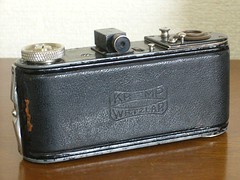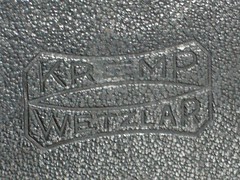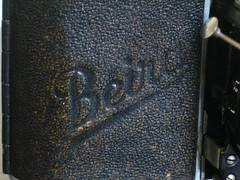Beira

|
| Early Beira with Rodenstock Trinar 5cm f/4.5 in a Pronto shutter image by Christoph Batz (Image rights) |
The Beira are 35mm folding cameras made by the young camera manufacturer Beier in Freital, Germany during the 1930s. On all the models, the square front standard is mounted on scissor struts. The first model released in 1931 belonged to the first competitive attempts using 35 mm film to enter the promising market of pocketable Small format cameras the Leica has created. However, it initially used an image format of 3x4 cm (on non perforated 35 mm film), unlike most of its competitors of 1931, which used 127 film. Later models were modified for perforated film and used the standard 24x36 mm format.
Beira, base model
The camera was announced at the Leipziger Frühjahrsmesse (spring fair in Leipzig, Germany) in 1931 as the Beika,[1] and released on the market later this year. The name was later changed to Beira.[2] The reason for that change is not known for sure, but maybe "Beika" sounded too close to "Leica". However, there seem to be no proof that the camera ever sold as Beika. The camera was sold by Birnbaum as the Birelle.[3]
The base model, produced from 1931 to ca. 1933 has a folding optical viewfinder, and takes 3×4cm images on unperforated film, which has to be loaded into special cassettes. (When loaded with perforated film, the usable exposure format is about 24×40mm.)[3]. Simple three-element lenses (like Trinar or Trioplan) have front element focussing. For all other lenses there is a focusing lever, moving the lens and shutter unit as a whole.
The following lenses and shutters were available (list based on sightings, may not be complete):
- Rodenstock Trinar 4.5/5cm, Pronto shutter
- Rodenstock Trinar 4.5/5cm, Compur shutter
- Meyer Trioplan 4.5/5cm, Vario shutter
- Meyer Trioplan 3.5/5cm, Compur shutter
- Meyer Trioplan 2.9/5cm, Compur shutter
- Schneider Xenar 3.5/5cm, Compur shutter
 
|
 
|
| Beira Ia rebadged as Kreca, tubular viewfinder, Kreca 5cm f/2.9 lens with no serial number, Compur shutter. Pictures by eBayer Yalluflex. (Image rights) |
Beira Ia and Beira II
From c.1933 or 1934 there were some adjustments and the camera was named Beira Ia. It now has a tubular viewfinder instead of the folding unit.[4] The camera was further modified: Instead of the rubber wheel of the base model, the typical sprocketed wheel for perforated 35 mm film was implemented and the image window resized to 24×36mm exposure format.[3][5] The new model can take a pair of standard film cassettes, but still has no rewind knob.
The Beira Ia and Beira II[6] versions were also rebadged as the Kreca, sold by Kremp. In 1935 the Beira II was launched, a coupled-rangefinder version, incorporating the Okula prismatic rangefinder made by Ernst Krauss in Jena.[7] With that equipment, the camera was also called Beira Okula.[3]The Beira Okula was still listed in a Beier catalogue dated Spring 1941,[8] then the production of the camera went to a halt during World War II.
For the later models the following lenses and shutters were available (list based on sightings, may not be complete):
- Schneider Xenar 2.9/5cm, Compur
- Schneider Xenon 2.0/4.5cm, Compur-Rapid
- Steinheil Cassar 2.9/5cm, Compur-Rapid
- Leitz Elmar 3.5/5cm, Compur-Rapid
 
|
| Beira II, Cassar 5cm f/2.9 lens, Compur-Rapid shutter. Pictures by eBayer Yalluflex. (Image rights) |
 
|
 
|
| Beira II, Xenar 5cm f/2.9 lens, Compur shutter. Pictures by eBayer Yalluflex. (Image rights) |
Notes
Bibliography
- More info and pictures of the Beira base model on KniPPsen
- Kadlubek, Günther, and Beier, Wolfgang. Kameras um Dresden herum. Beier, Pouva, Welta & Co. Stuttgart: Lindemanns Verlag, 2003.
- McKeown, James M. and Joan C. McKeown's Price Guide to Antique and Classic Cameras, 12th Edition, 2005-2006. USA, Centennial Photo Service, 2004. ISBN 0-931838-40-1 (hardcover). ISBN 0-931838-41-X (softcover). Pp.116 and 561.